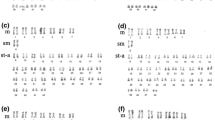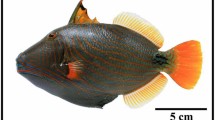Abstract
A non-repetitive genomic DNA region of about 25 kb was cloned from the W chromosome of chicken using a genomic library prepared from a single W chromosome of the chicken. This region was mapped by fluorescence in situ hybridization (FISH) with mitotic and lampbrush chromosomes to a position between the major EcoRI family and the pericentromeric XhoI family on the W chromosome. A 0.6-kb EcoRI fragment(EE0.6) subcloned from this region consists of a sequence that can be obtained by the exon-trapping procedure and flanking sequences. Sequences, which are closely similar to that of EE0.6, are widely conserved on the W chromosomes of Carinatae birds, as revealed by Southern blot hybridization to HindIII-digested female and male genomic DNAs from 18 species of birds belonging to eight different taxonomic orders. The female sex of those birds can be determined by the presence of an unambiguous female-specific band. For many species of birds, the female sex can also be determined by polymerase chain reaction (PCR) using a set of primers from the flanking sequences in the chicken EE0.6.
Similar content being viewed by others
References
Ansari HA, Takagi N, Sasaki M (1986) Interordinal conservatism of chromosome banding patterns in Gallus domesticus (Galliformes) and Melopsittacus undulatus (Psittaciformes). Cytogenet Cell Genet 43: 6–9.
Buckler AJ, Chang DD, Graw SL et al. (1991) Exon amplification: a strategy to isolate mammalian genes based on RNA splicing. Proc Natl Acad Sci USA 88: 4005–4009.
Clinton M (1994) A rapid protocol for sexing chick embryos (Gallus g. domesticus). Anim Genet 25: 361–362.
Dvorak J, Halverson JL, Gulick P et al. (1992) cDNA cloning of a Z-and W-linked gene in Gallinaceous birds. J Hered 83: 22–25.
Feinberg AP, Vogelstein B (1983) A technique for radiolabeling DNA restriction endonuclease fragments to high specific activity. Anal Biochem 132: 6–13.
Griffiths R, Tiwari B (1993) The isolation of molecular genetic markers for the identification of sex. Proc Natl Acad Sci USA 90: 8324–8326.
Griffiths R, Tiwari B (1995) Sex of the last wild Spix's macaw. Nature 375: 454.
Griffiths R, Daan S, Dijkstra C (1996) Sex identification in birds using two CHD genes. Proc R Soc Lond B 263: 1251–1256.
Hadano S, Watanabe M, Yokoi H et al. (1991) Laser micro-dissection and single unique primer PCR allow generation of regional chromosome DNA clones from a single human chromosome. Genomics 11: 364–373.
Halverson JL, Dvorak J (1993) Genetic control of sexdetermination in birds and the potential for its manipulation. Poultry Sci 72: 890–896.
Hori T, Suzuki Y, Solovei I et al. (1996) Characterization of DNA sequences constituting the terminal heterochromatin of the chicken Z chromosome. Chrom Res 4: 411–426.
Kagami H, Clark ME, Gibbins AMV, Etches RJ (1995) Sexual differentiation of chimeric chickens containing ZZ and ZW cells in the germline. Mol Reprod Dev 42: 379–387.
Kaul D, Ansari HA (1978) Chromosome studies in three species of Piciformes (Aves). Genetica 48: 1930–1960.
Kodama H, Saitoh H, Tone M, Kuhara S, Sakaki Y, Mizuno S (1987) Nucleotide sequences and unusual electrophoretic behavior of the W chromosome-specific repeating DNA units of the domestic fowl, Gallus gallus domesticus. Chromosoma 96: 18–25.
Lin M, Thorne MH, Martin ICA, Sheldon BL, Jones RC (1995) Development of the gonads in the triploid (ZZWand ZZZ) fowl, Gallus domesticus, and comparison with normal diploid males (ZZ) and females (ZW). Reprod Fertil Dev 7: 1185–1197.
Longmire JL, Ambrose RE, Brown NC et al. (1991) Use of sex-linked minisatellite fragments to investigate genetic differentiation and migration of North American populations of the peregrine falcon (Falco peregrinus). In: Burke T, Dolf G, Jeffreys AJ, Wolff R, eds. DNA Fingerprinting. Approaches and Applications. Basle: Bukhauser Verlag, pp 217–229.
Mizuno S, Saitoh Y, Nomura O et al. (1993) Sex-specific DNA sequences in Galliformes and their application to the study of sex differentiation. In: Etches RJ, Gibbins AMV, eds. Manipulation of the Avian Genome. Boca Raton: CRC Press, pp 257–274.
Ohno S (1967) Sex chromosomes and sex-linked genes. In: Labhart A, Mann T, Samuels LT, eds. Monographs on Endocrinology Vol. 1. Heidelberg: Springer-Verlag.
Quinn TW, White BN (1987) Identification of restriction-fragment-length polymorphisms in genomic DNA of the Lesser Snow Goose (Anser caerulescens caerulescens). Mol Biol Evol 4: 126–143.
Rabenold PP, Piper WH, Decker MD, Minchella DJ (1991) Polymorphic minisatellite amplified on avian W chromosome. Genome 34: 489–493.
Raman R, Jacob M, Sharma T (1978) Heterogeneity in distribution of constitutive heterochromatin in four species of birds. Genetica 48: 61–65.
Saitoh Y, Mizuno S (1992) Distribution of XhoI and EcoRI family repetitive DNA sequences into separate domains in the chicken W chromosome. Chromosoma 101: 474–477.
Saitoh H, Harata M, Mizuno S (1989) Presence of female-specific bent-repetitive DNA sequences in the genomes of turkey and pheasant and their interactions with W-protein of chicken. Chromosoma 98: 250–258.
Saitoh Y, Saitoh H, Ohtomo K, Mizuno S (1991) Occupancy of the majority of DNA in the chicken W chromosome by bent-repetitive sequences. Chromosoma 101: 32–40.
Saitoh Y, Ogawa A, Hori T, Kunita R, Mizuno S (1993) Identification and localization of two genes on the chicken Z chromosome: implication of evolutionary conservation of the Z chromosome among avian species. Chrom Res 1: 239–251.
Sambrook J, Fritsch EF, Maniatis T (1989) Molecular Cloning. A Laboratory Manual, 2nd edn, Vol. 2. Cold Spring Harbor Laboratory Press: Cold Spring Harbor, NY, pp 11.52–11.53.
Shapiro MB, Senapathy P (1987) RNA splice junctions of different classes of eukaryotes: sequence statistics and functional implications in gene expression. Nucleic Acids Res 15: 7155–7174.
Sheldon BL, Thorne MH (1995) Sex determination in birds from the perspective of studies on triploid intersexes (abstract 10.01-Oral). VI International Symposium on Avian Endocrinology, Chateau Lake Louise, Alberta, 31 March 5 April 1996. In: Poultry and Avian Biology Reviews 6: 306.
Simmler M-C, Rouyer F, Vergnaud G et al. (1985) Pseudoau-tosomal DNA sequences in the pairing region of the human sex chromosomes. Nature 317: 692–697.
Sinclair AH, Berta P, Palmer MS et al. (1990) A gene from the human sex-determining region encodes a protein with homology to a conserved DNA-binding motif. Nature 346: 240–244.
Solari AJ, Dresser ME (1995) High-resolution cytological localization of the XhoI and EcoRI repeat sequences in the pachytene ZW bivalent of the chicken. Chrom Res 3: 87–93.
Solovei I, Gaginskaya E, Hutchison N, Macgregor H (1993) Avian sex chromosomes in the lampbrush form: ZW lamp-brush bivalents from six species of bird. Chrom Res 1: 153–166.
Suka N, Shinohara Y, Saitoh Y et al. (1993) W-heterochromatin of chicken: its unusual DNA components, late replication, and chromatin structure. Genetica 88: 93–105.
Tone M, Sakaki Y, Hashiguchi T, Mizuno S (1984) Genus specificity and extensive methylation of the W chromo-some-specific repetitive DNA sequences from the domestic fowl, Gallus gallus domesticus. Chromosoma 89: 228–237.
Uryu N, Nagata Y, Ito K, Saitoh H, Mizuno S (1989) Determination of the sex of chickens by a biotin-labeled deoxyribonucleic acid probe. Poultry Sci 68: 850–853.
Wade J, Arnold AP (1996) Functional testicular tissue does not masculinize development of the zebra finch song system. Proc Natl Acad Sci USA 93: 5264–5268.
Author information
Authors and Affiliations
Rights and permissions
About this article
Cite this article
Ogawa, A., Solovei, I., Hutchison, N. et al. Molecular characterization and cytological mapping of a non-repetitive DNA sequence region from the W chromosome of chicken and its use as a universal probe for sexing Carinatae birds. Chromosome Res 5, 93–101 (1997). https://doi.org/10.1023/A:1018461906913
Issue Date:
DOI: https://doi.org/10.1023/A:1018461906913




